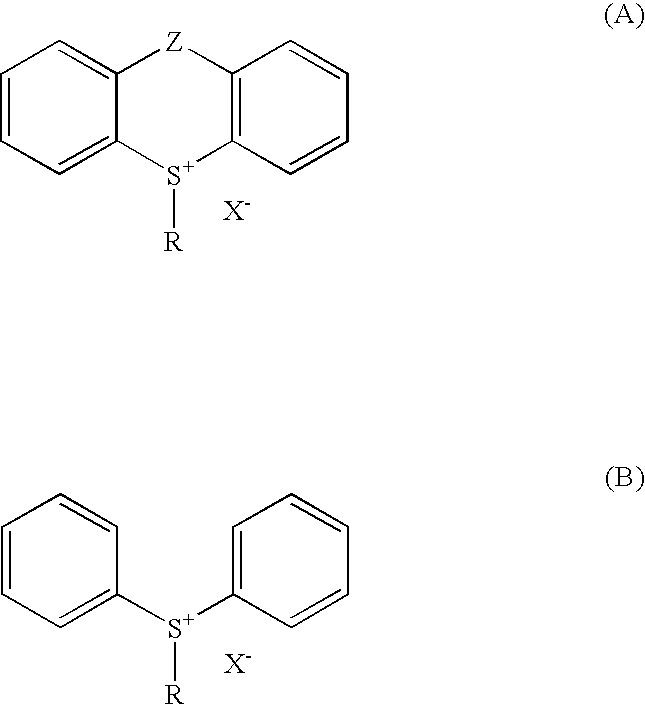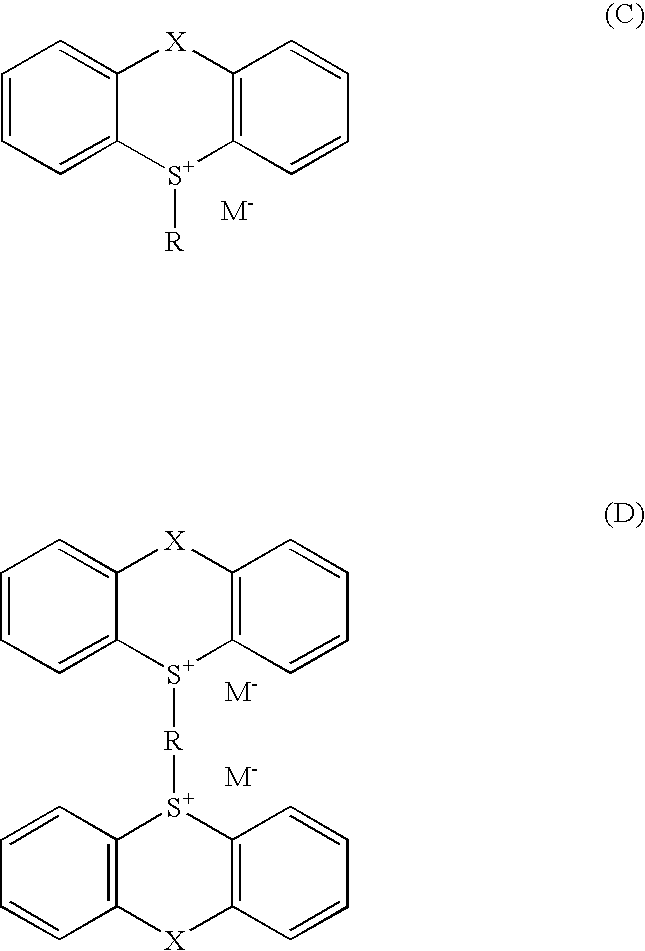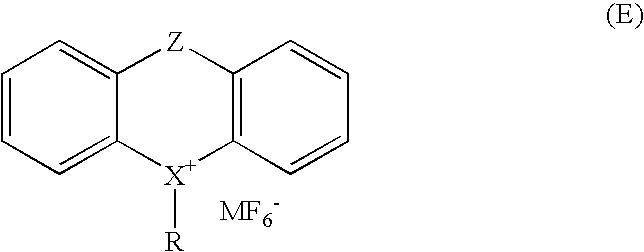Sulfoniun salts, methods for their preparation and use thereof as photoinitiators for radiation curable systems
a technology of sulfonium salts and salts, which is applied in the field of sulfonium salts, can solve problems such as problems in the use of sulfonium salts
- Summary
- Abstract
- Description
- Claims
- Application Information
AI Technical Summary
Benefits of technology
Problems solved by technology
Method used
Image
Examples
example 1
[0132]To a well stirred solution of thianthrene (22.3 g; 100 mmol) and glacial acetic acid (400 g) at 90° C. was added drop wise hydrogen peroxide 35% (11.3 g; 99.7 mmol) over 55 minutes. After 2 hours 0.5 g of hydrogen peroxide were added and after 30 minutes the mixture was poured into water and the solid was collected by suction filtration and washed with water. The filter cake was dried under vacuum to give a white solid (17.8 g) in a yield of 77% with melting point of 148° C.
[0133]1HNMR (CDCl3):δ(ppm):7.39-7.48 (m,2H); 7.52-7.60 (m,2H); 7.61-7.66 (d,2H): 7.91-7.97 (d,2H)
[0134]MS:233.1 (M+1)
example 2
4,4′-bis(thianthrenium-9-yl)-diphenylether dihexafluorophosphate
[0135]To a solution of diphenylether (3 g), thianthrene-9-oxide (4.06 g) and tetrachloroethylene (200 g) aluminium chloride (7 g) was added in one portion. The suspension was stirred at a gentle reflux for 75 minutes. Then tetrachloroethylene (60 g), thianthrene-9-oxide (4.64 g) and aluminium chloride (8 g) were added maintaining the same condition of reaction. To complete the reaction 0.6 g of thiantrene-9-oxide were further added and the reaction mixture was stirred under reflux for 30 minutes more. The mixture was then poured into water, filtered and washed with ethyl ether. The aqueous phase was added drop wise in a solution of 8.5 g of potassium hexafluorophosphate dissolved in 2 litres of distilled water. The solid precipitated from the solution was collected by suction filtration and washed with water. The filter cake was dried to give a white solid (14.6 g) in a yield of 93.7%.
[0136]1HNMR (DMSOd6): δ(ppm):7.16 (...
example 3
4,4′-bis-(thianthrenium-9-yl)-diphenyl dihexafluorophosphate
[0138]A mixture of biphenyl (0.77 g), thianthrene-9-oxide (1.16 g), aluminium chloride (2 g) and tetrachloroethylene (85 g) was stirred at a gentle reflux for 75 minutes. Then tetrachloroethylene (22 g), thiantrene-9-oxide (1.33 g) and aluminium chloride (2.64 g) were added maintaining the same condition. After 75 minutes dilute chloridric acid was added slowly. The extract was treated with a solution of potassium hexafluorophosphate (2.5 g) dissolved in 100 g of water. A white precipitate (0.1 g) was obtained with a m.p. of 140° C.
[0139]1HNMR (DMSOd6):δ(ppm):7.28-7.38 (m,4H); 7.76-8.00 (m,12H); 8.01-8.13 (m,4H); 8.55-8.66 (m,4H)
[0140]MS:729 (M)
PUM
| Property | Measurement | Unit |
|---|---|---|
| molar ratio | aaaaa | aaaaa |
| molar ratio | aaaaa | aaaaa |
| molar ratio | aaaaa | aaaaa |
Abstract
Description
Claims
Application Information
 Login to View More
Login to View More - R&D
- Intellectual Property
- Life Sciences
- Materials
- Tech Scout
- Unparalleled Data Quality
- Higher Quality Content
- 60% Fewer Hallucinations
Browse by: Latest US Patents, China's latest patents, Technical Efficacy Thesaurus, Application Domain, Technology Topic, Popular Technical Reports.
© 2025 PatSnap. All rights reserved.Legal|Privacy policy|Modern Slavery Act Transparency Statement|Sitemap|About US| Contact US: help@patsnap.com



